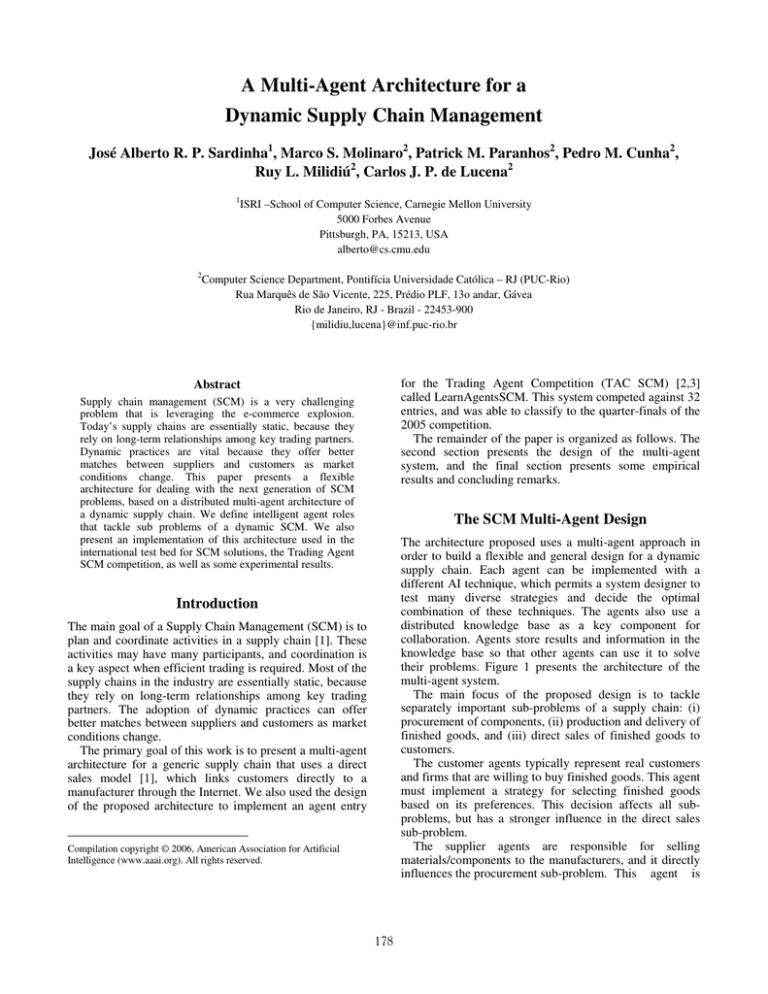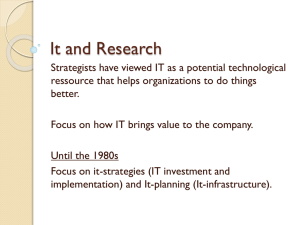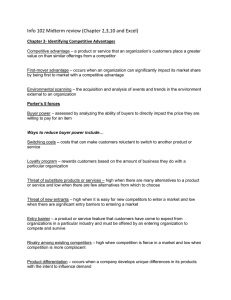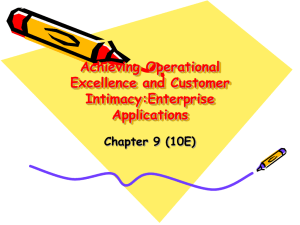
A Multi-Agent Architecture for a
Dynamic Supply Chain Management
José Alberto R. P. Sardinha1, Marco S. Molinaro2, Patrick M. Paranhos2, Pedro M. Cunha2,
Ruy L. Milidiú2, Carlos J. P. de Lucena2
1
ISRI –School of Computer Science, Carnegie Mellon University
5000 Forbes Avenue
Pittsburgh, PA, 15213, USA
alberto@cs.cmu.edu
2
Computer Science Department, Pontifícia Universidade Católica – RJ (PUC-Rio)
Rua Marquês de São Vicente, 225, Prédio PLF, 13o andar, Gávea
Rio de Janeiro, RJ - Brazil - 22453-900
{milidiu,lucena}@inf.puc-rio.br
for the Trading Agent Competition (TAC SCM) [2,3]
called LearnAgentsSCM. This system competed against 32
entries, and was able to classify to the quarter-finals of the
2005 competition.
The remainder of the paper is organized as follows. The
second section presents the design of the multi-agent
system, and the final section presents some empirical
results and concluding remarks.
Abstract
Supply chain management (SCM) is a very challenging
problem that is leveraging the e-commerce explosion.
Today’s supply chains are essentially static, because they
rely on long-term relationships among key trading partners.
Dynamic practices are vital because they offer better
matches between suppliers and customers as market
conditions change. This paper presents a flexible
architecture for dealing with the next generation of SCM
problems, based on a distributed multi-agent architecture of
a dynamic supply chain. We define intelligent agent roles
that tackle sub problems of a dynamic SCM. We also
present an implementation of this architecture used in the
international test bed for SCM solutions, the Trading Agent
SCM competition, as well as some experimental results.
The SCM Multi-Agent Design
The architecture proposed uses a multi-agent approach in
order to build a flexible and general design for a dynamic
supply chain. Each agent can be implemented with a
different AI technique, which permits a system designer to
test many diverse strategies and decide the optimal
combination of these techniques. The agents also use a
distributed knowledge base as a key component for
collaboration. Agents store results and information in the
knowledge base so that other agents can use it to solve
their problems. Figure 1 presents the architecture of the
multi-agent system.
The main focus of the proposed design is to tackle
separately important sub-problems of a supply chain: (i)
procurement of components, (ii) production and delivery of
finished goods, and (iii) direct sales of finished goods to
customers.
The customer agents typically represent real customers
and firms that are willing to buy finished goods. This agent
must implement a strategy for selecting finished goods
based on its preferences. This decision affects all subproblems, but has a stronger influence in the direct sales
sub-problem.
The supplier agents are responsible for selling
materials/components to the manufacturers, and it directly
influences the procurement sub-problem. This agent is
Introduction
The main goal of a Supply Chain Management (SCM) is to
plan and coordinate activities in a supply chain [1]. These
activities may have many participants, and coordination is
a key aspect when efficient trading is required. Most of the
supply chains in the industry are essentially static, because
they rely on long-term relationships among key trading
partners. The adoption of dynamic practices can offer
better matches between suppliers and customers as market
conditions change.
The primary goal of this work is to present a multi-agent
architecture for a generic supply chain that uses a direct
sales model [1], which links customers directly to a
manufacturer through the Internet. We also used the design
of the proposed architecture to implement an agent entry
Compilation copyright © 2006, American Association for Artificial
Intelligence (www.aaai.org). All rights reserved.
178
normally a manufacturer and could also use the design of
the manufacturer proposed in figure 1.
scheduler agent, and (iii) direct sales of finished goods to
customers - Sales representative agent and Marketing
manager agent.
These agents use the corporate knowledge base to
exchange important information for decision making
purpose. This collaboration has the ultimate goal of
achieving the maximum profitability for the manufacturer
organization.
Empirical Results and Concluding Remark
The 2005 TAC SCM competition had 32 entries from
different research institutions around the world, and only
the 24 best agents were classified for the final rounds. We
implemented an entry for the 2005 TAC SCM called
LearnAgentsSCM, and our system classified to the quarterfinals because it finished the preliminary round in the 16th
place. Table 1 presents the final results of the Quarterfinals.
Figure 1: The Multi-Agent Architecture
The manufacturer of finished goods, also called
manufacturer organization, is composed of the following
agents:
• Sales Representative agent – is responsible for fulfilling
customer orders. Typically, this agent has to decide the
price of finished goods based on current demand and the
probability of winning customer orders. In
LearnAgentsSCM, these decisions are based on a
stochastic programming model;
• Marketing manager agent – has to select the best
customers and market segments in order to maximize the
manufacturer’s profitability. In LearnAgentsSCM, this
agent uses a greedy strategy that chooses the most
profitable Request-For-Quotes (in terms of its profit per
factory cycles) and allocate them on the earliest date
possible;
• Production scheduler agent and Delivery scheduler agent
– have to optimize the schedule of the production and
delivery of finished goods respectively. Both production
and delivery are decided at the same time in
LearnAgentsSCM. We reuse the model adopted in the
Marketing Manager with some minor differences;
• Procurement buyer agent – negotiates components with
supplier based on attributes such as price and delivery
time. In LearnAgentsSCM, this agent uses a simple
heuristic that selects a component with the cheapest price
after receiving responses from suppliers’ Request-ForQuotes;
• Procurement manager agent – decides when to buy
components based on the current inventory and
component demand. In LearnAgentsSCM, a multiresolution procurement model is used in this agent.
The design of the manufacturer tackles the sub-problems
mentioned above with the following agents: (i)
procurement of components - Procurement buyer agent and
Procurement manager agent, (ii) production and delivery of
finished goods - Production scheduler agent and Delivery
1
2
3
4
5
6
Position
Agent
Average Score
TacTex-05
17.78 M
MinneTAC
11.91 M
PhantAgent
7.026 M
Remix
6.686 M
LearnAgentsSCM
4.683 M
BonteKoe
-2.200 M
Table 1: Final scores of the 2005 Quarter-finals
The primary goal of this work is to present a multi-agent
architecture for a generic supply chain that uses a direct
sales model, which links customers to a manufacturer
through the Internet. A multi-agent design is used in the
architecture, because we believe it facilitates the
development of modular entities that are distributed and
reusable. The design was also used to implement an agent
entry for the Trading Agent Competition. This system
competed against 32 entries, and was able to classify to the
quarter-finals of the 2005 competition.
References
[1] Chopra, S., and Meindl, P.. Supply Chain Management
– Strategy, Planning, and Operations. Second Edition
Pearson Prentice Hall, 2004.
[2] Arunachalam, R. and Sadeh, N.. The Supply Chain
Trading Agent Competition. Electronic Commerce
Research and Applications, Volume 4, Issue 1, Pages 6684, Spring 2005.
[3] Collins, J., Arunachalam, R., Sadeh, N., Eriksson, J.,
Finne, N., Janson, S.. The Supply Chain Management
Game for the 2005 Trading Agent Competition. School of
Computer Science, Carnegie Mellon University, Technical
Report CMU-ISRI-04-139, December 2004.
179





